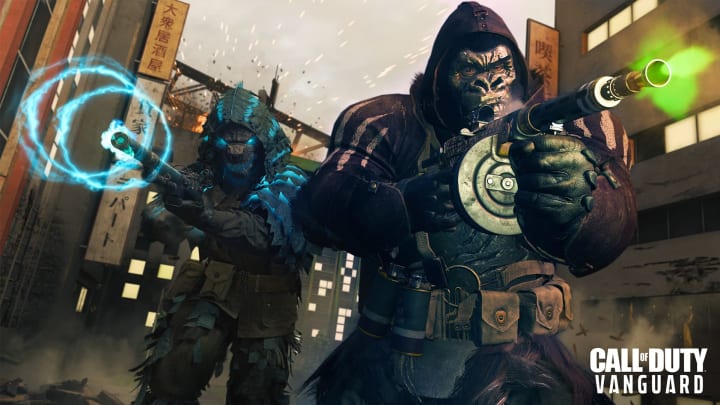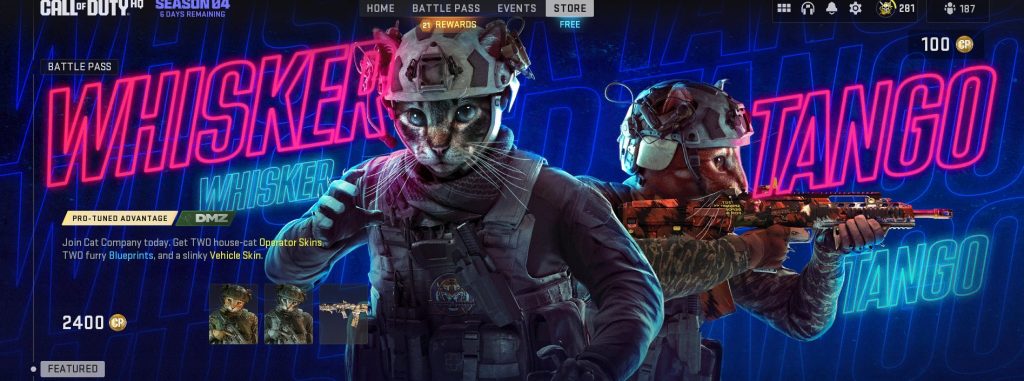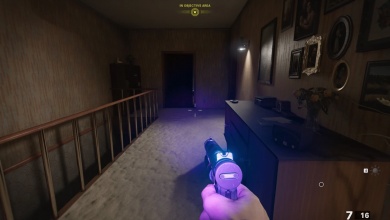Story Highlights
- Fortnite has made a name for itself for its wide range of collaborations.
- Other games like Call of Duty have tried to imitate that success.
- Call of Duty seems to have lost itself over the last couple of years, especially recently.
Fortnite popularized battle passes, exclusive microtransactions, and seasonal live service content, at least popularized what they are today. In that success, with millions of players and billions of dollars made, other games have looked to capitalize on the success of Fortnite and introduce microtransactions and seasonal content of their own, with Call of Duty being the best example.
The COD franchise started off as a WW2 franchise, with multiple games set in that era. Modern Warfare would later release, and then games set in the near and far future, but these games always had some grounding and weren’t ever over the top cartoonish. But with recent COD releases, the idea of realism in the game has come into debate, as COD tries to follow in Fortnite’s footsteps.
New Call of Duty games, at least their multiplayer can be characterized by wacky skins, forgoing of realism, and partnerships with external companies for marketing and cosmetic in-game items, a page taken from Fortnite and its successful use of this.
Live Service Makes Money
What makes more money, releasing 4 15 dollar map packs for every Call of Duty release, or making the map content free but having a wide range of exclusive, short-timed skins and operators that cost $15-20 each? If you are in the gaming business, the latter is much better for revenue, especially nowadays when game development is so expensive.
Live service is so important to modern gaming companies, that a majority of their revenue comes from live service content. Electronic Arts, for example, had 71% of its revenue coming in from live service at one point, according to company executives.
71% of EA's revenue is coming from live service games.
— Geoff Keighley (@geoffkeighley) May 10, 2022
Activision and the Call of Duty franchise are no different. The newest COD games are designed around live service because it makes a lot of f@#king money! And if you are a business, that is the whole point, right? Activision, EA, and Take-Two would never ever give up microtransactions or live service no matter how much some consumers might complain.
With the addition of Warzone, a free-to-play battle royale game, microtransactions, and live service went into overdrive, the foundations of all modern Call of Duty games are built with Warzone in mind, and the necessity to push lots of live service content for it. Because of this, realism and tradition take a back seat, as wacky and unique cosmetics take center stage.
Who Cares About Realism?

Call of Duty has become less and less realistic over the past couple of years, and this was especially exaggerated In Call of Duty: Vanguard’s multiplayer. Some purists derided Vanguard as a mockery of the original COD games, with skins and cosmetics that had absolutely nothing to do with WW2.
To be honest, the COD franchise was never realistic, with esoteric game modes and lore involving zombies and other unrealistic entities. Even the multiplayer campaigns in past COD games had a be-the-hero, save-the-world type of story, although most games excluding the futuristic ones were at least grounded to some level.
If people truly cared about realism in games, then other titles like Hell Let Loose and Enlisted would be much more popular than they are, but the reality people like Call of Duty because it is fun, not because it is realistic. The average gamer does not have the attention span to play a full milsim match of Arma 4 or Squad. Younger gamers do not care about realism and like all the colors and pizazz of newer COD titles.
But are things getting out of hand? Recently, it was announced that Nicki Minaj would come to Modern Warfare 2, and this is on top of the other odd purchasable operators playable in the game, including Snoop Dog, a cat, and Homelander from The Boys among others.
https://twitter.com/CallofDuty/status/1684625031014252544
Because of this, it seems like Call of Duty multiplayer has shifted in an odd direction, trying to emulate the wackiness and colorfulness of Fortnite, while losing its groundedness. 10 years ago no one bought skins, you just bought the base game and maybe the map packs as they came out. But consumers are more interested in wacky cosmetics than 10 years ago.

There are a large number of older Call of Duty fans who bemoan this direction, and other franchises are not so different. Battlefield 2042 faced criticism from its fans for trying to go into a live service-type direction with the franchise, from live service, battle passes to wacky skins, and a controversial specialist system that EA blamed the players for not understanding.
I myself complain about the direction of some of these games, including Call of Duty and its Fortniteization, but I still sometimes buy the battle passes if a season is interesting or there are some unique skins that I really like. Almost all FPS games have gone in this direction, from COD to Battlefield to HALO and others, it is simply the reality of what consumers expect from FPS titles.
Now, these wacky cosmetics are another way for a lot of players to express themselves. In older COD multiplayer, the only customization options were really weapon skins, more customization options mean more cosmetics for players to choose from, which means more cosmetics that can be sold to players.
Fortniteification Has Made Call of Duty Bloated
If you haven’t noticed, every new COD game released in the last couple of years is bloated. 100 gigabytes here, a 20-gigabyte update there. These games are massive, compared to how small they used to be. 2011’s COD MW3 was only 16 gigabytes.
A lot of that room nowadays is taken up by HD textures, and maps that are multiple times more detailed than they were in the past. Since COD has moved to seasonal releases, its studios have the obligation to push out tons of content in a relatively short time, as well as develop tons of cosmetic items for sale.
Call of Duty was once a franchise that rotated between 3 studios, Treyarch, Infinity Ward, and Sledgehammer. This is still true, every new COD game has a head developer but today’s COD games are developed by a consortium of nearly a dozen studios with thousands of developers. This has increased the cost of developing Call of Duty games, and thus more revenue is required to offset these high development costs.
All these developers are needed to be able to meet the content demands of consumers, and the lines have blurred on what studio is working on what project because all major COD studios seem to be working on all projects simultaneously.
Final Thoughts
Gaming has changed over the past 2 decades, and consumer activity and expectations of their games couldn’t stay the same forever. However, I wonder what the franchise would look like today if it didn’t follow the same formula as Fortnite and others, and if the franchise’s core DNA stayed relatively the same. COD was always an arcadey franchise, but now I wonder if it is too arcadey.
Thanks! Do share your feedback with us. ⚡
How can we make this post better? Your help would be appreciated. ✍



